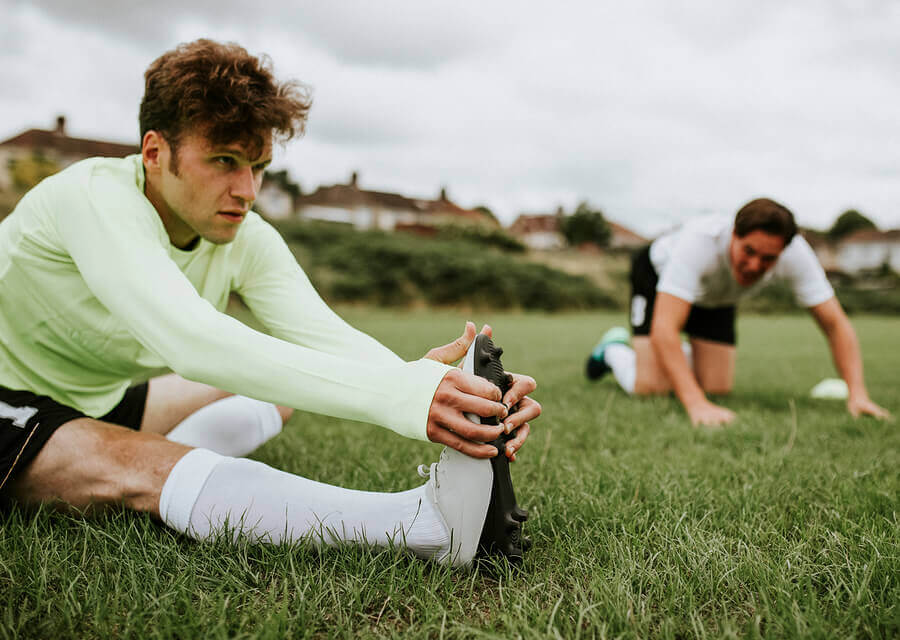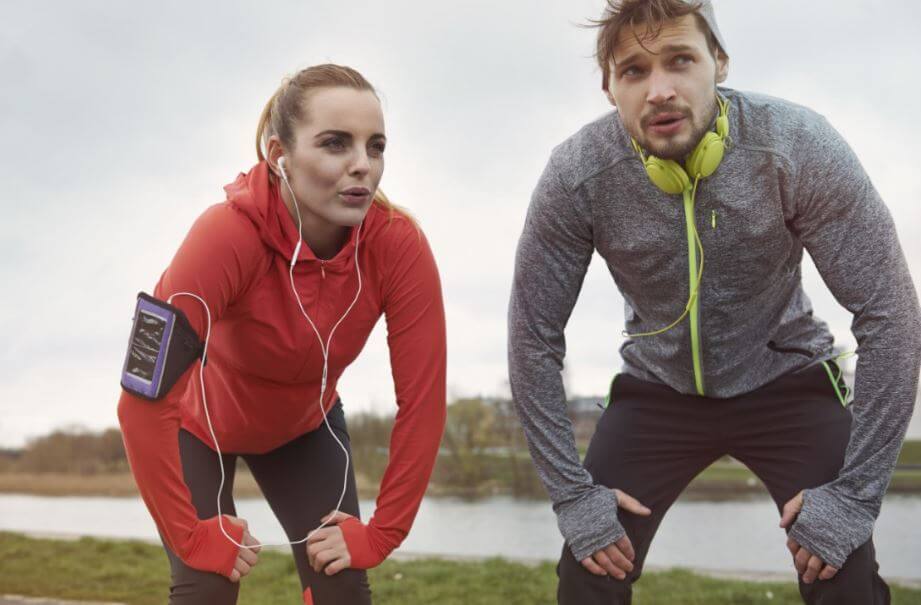Relaxation Methods After Sports

After practicing sports, it’s important to relax your muscles. This will allow the muscles to stop contracting and stimulate blood flow. It’s important for both the mind and body to relax. The following exercises include relaxation techniques for the muscles, respiratory system, and the mind.
Practicing sports is rewarding, but it certainly implies stress on many levels. However, every individual has specific tools they can use to return to a state of rest. In the following article, we’ll share a few relaxation tools with you.
From movement to rest in a progressive way
Footballers, sprinters and other athletes don’t cease their activity as soon as the competition ends. Their last movements and exercises are usually performed several minutes after competing. Therefore, they move from movement to rest in a progressive way.
Every good athlete reduces energy output progressively. Even when the sporting activity is interrupted, it’s good to keep walking a little bit before stopping completely. During progressive cool downs, you can take advantage of the time to perform stretching exercises.
Stretching should also be performed at the end
Stretching before training is very beneficial and it helps prevent injuries. However, stretching should occur right after physical activities as well. This will allow blood to circulate through the muscles when resting.
Stretching after training is a method of muscle relaxation in itself. If you feel some sort of pain, you will surely find some relief when stretching. In that sense, it’s best to start with simple limb extensions.

In high-impact sports, stretching is usually focused on the most commonly used muscle groups. For example, soccer players usually perform leg extensions on the floor. To do this, they stretch their lower extremities creating a ‘V’ shape while leaning forward.
When it comes to basketball and baseball, hip movements and upper body stretching are usually more important. This is because these sports don’t involve as much use of the lower extremities. Arm extensions and head movements are usually performed in all disciplines.
Relaxation during sports: breathing
Breathing is one of the issues that we should pay a lot of attention to after training. Energy expenditure and respiratory demand rise during exercise. Therefore, at the end of the day, it’s important to pause and breathe.
Our respiratory needs should not prevent us from progressively slowing down. When you feel out of breath, you can raise your arms up and down as you inhale and exhale. Performing vocalizations during exhalations can also help restore breathing capacity.

It’s also important to focus on inhaling large breaths of air. Sipping water is another strategy that can help to improve brain oxygenation.
Physiotherapy and its role in sports
Many athletes receive physiotherapy after training, even though you don’t see it on the television. In fact, it’s very common in sports such as soccer, for players to have specialized rooms with stretchers where players are attended to by professionals.
The physiotherapist is the ideal professional to apply body massages. However, players can also apply pressure to affected areas themselves. Whatever the case, the massages should be performed slowly and in a gentle manner.

The mind needs to relax after training
Sports bring along considerable mental stress. Therefore, many athletes unconsciously seek to clear their minds after exercising. The habit of taking deep breaths can be useful to relax the mind. Oxygenation is key to human relaxation.
Another important tool is to think about pleasurable moments outside the sporting activity. Of course, winning is the objective, however, if you don’t reach your objective you should not focus on it. Some psychologists recommend clearing the mind, however, this can be a complicated process.
In conclusion, you can see that there are many methods that athletes apply intuitively. Regardless, relaxation is an aspect that we should all invest time and attention to. The objective is to head towards mental and physical relaxation.
After practicing sports, it’s important to relax your muscles. This will allow the muscles to stop contracting and stimulate blood flow. It’s important for both the mind and body to relax. The following exercises include relaxation techniques for the muscles, respiratory system, and the mind.
Practicing sports is rewarding, but it certainly implies stress on many levels. However, every individual has specific tools they can use to return to a state of rest. In the following article, we’ll share a few relaxation tools with you.
From movement to rest in a progressive way
Footballers, sprinters and other athletes don’t cease their activity as soon as the competition ends. Their last movements and exercises are usually performed several minutes after competing. Therefore, they move from movement to rest in a progressive way.
Every good athlete reduces energy output progressively. Even when the sporting activity is interrupted, it’s good to keep walking a little bit before stopping completely. During progressive cool downs, you can take advantage of the time to perform stretching exercises.
Stretching should also be performed at the end
Stretching before training is very beneficial and it helps prevent injuries. However, stretching should occur right after physical activities as well. This will allow blood to circulate through the muscles when resting.
Stretching after training is a method of muscle relaxation in itself. If you feel some sort of pain, you will surely find some relief when stretching. In that sense, it’s best to start with simple limb extensions.

In high-impact sports, stretching is usually focused on the most commonly used muscle groups. For example, soccer players usually perform leg extensions on the floor. To do this, they stretch their lower extremities creating a ‘V’ shape while leaning forward.
When it comes to basketball and baseball, hip movements and upper body stretching are usually more important. This is because these sports don’t involve as much use of the lower extremities. Arm extensions and head movements are usually performed in all disciplines.
Relaxation during sports: breathing
Breathing is one of the issues that we should pay a lot of attention to after training. Energy expenditure and respiratory demand rise during exercise. Therefore, at the end of the day, it’s important to pause and breathe.
Our respiratory needs should not prevent us from progressively slowing down. When you feel out of breath, you can raise your arms up and down as you inhale and exhale. Performing vocalizations during exhalations can also help restore breathing capacity.

It’s also important to focus on inhaling large breaths of air. Sipping water is another strategy that can help to improve brain oxygenation.
Physiotherapy and its role in sports
Many athletes receive physiotherapy after training, even though you don’t see it on the television. In fact, it’s very common in sports such as soccer, for players to have specialized rooms with stretchers where players are attended to by professionals.
The physiotherapist is the ideal professional to apply body massages. However, players can also apply pressure to affected areas themselves. Whatever the case, the massages should be performed slowly and in a gentle manner.

The mind needs to relax after training
Sports bring along considerable mental stress. Therefore, many athletes unconsciously seek to clear their minds after exercising. The habit of taking deep breaths can be useful to relax the mind. Oxygenation is key to human relaxation.
Another important tool is to think about pleasurable moments outside the sporting activity. Of course, winning is the objective, however, if you don’t reach your objective you should not focus on it. Some psychologists recommend clearing the mind, however, this can be a complicated process.
In conclusion, you can see that there are many methods that athletes apply intuitively. Regardless, relaxation is an aspect that we should all invest time and attention to. The objective is to head towards mental and physical relaxation.
All cited sources were thoroughly reviewed by our team to ensure their quality, reliability, currency, and validity. The bibliography of this article was considered reliable and of academic or scientific accuracy.
- Sergio Mosconi, María Susana Correche, María Fernanda Rivarola. 2007. Aplicación de la técnica de relajación en deportistas de 16 años para mejorar su rendimiento. Extraído de: http://fundamentos.unsl.edu.ar/pdf/articulo-16-183.pdf
- Valentina García Moliz. Activación, estrés, ansiedad y rendimiento. Extraído de: http://defidepor25.ugr.es/acrd/alumnos/document/clases/9.pdf
This text is provided for informational purposes only and does not replace consultation with a professional. If in doubt, consult your specialist.








